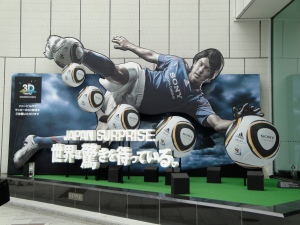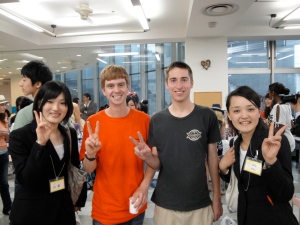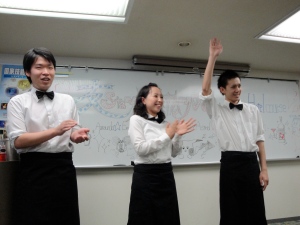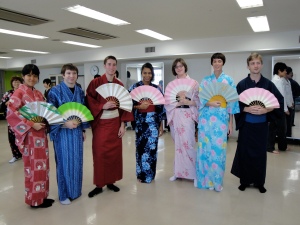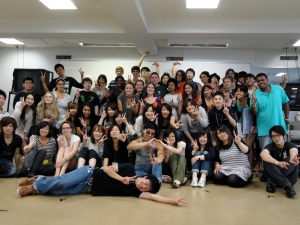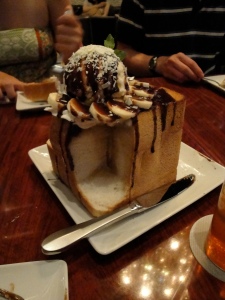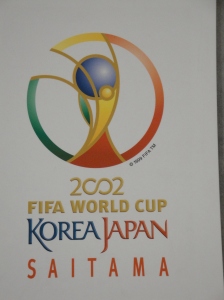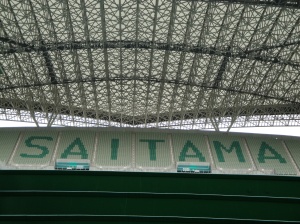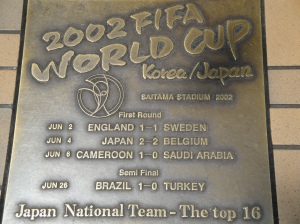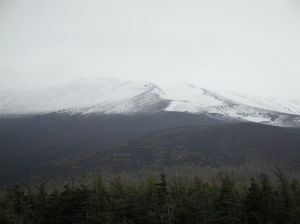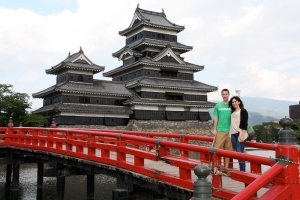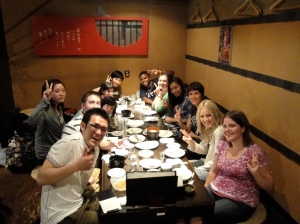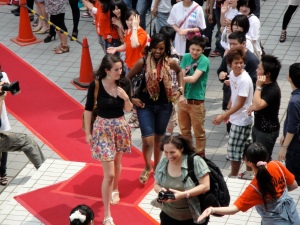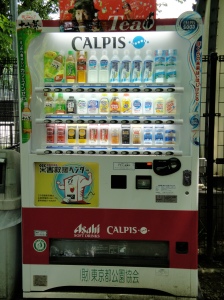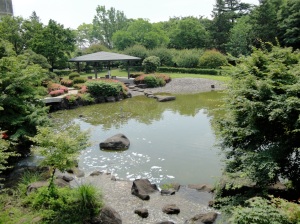Technos International Week – Day 14
Saturday June 19, 2010
NARITA INTERNATIONAL AIRPORT, Ueno, Japan – I guess it’s true what they say about life. Life really is made up for beginnings and ends. So ends this. I could write about our last morning and the emotions everyone was feeling. I could write about how we woke up for our last morning in Japan, ate breakfast, packed our belongings and left for the airport to eventually board our airplanes destined for separate destinations. Yet all of that information is relatively unimportant in the larger scheme of things. What is important is the beginning and the journey to this end. We arrived here as complete strangers in a land that was a complete mystery to us. A few people spoke some part of the language, but no one was completely fluent. We were strangers in a strange land, lost in a new culture, yet eager to learn as much as we possibly could. The two weeks that I spent in Japan flew by faster than I could have imagined, yet it also felt like a lifetime and I enjoyed every minute of it. Our Technos hosts were unbelievable and went out of their way to show us a great time. Then there was the tearful goodbye, but I didn’t look at it that way. While I was saying goodbye to this trip, I knew I would be starting another one soon. Although I am finished with this trip to Japan, I know that one day I will return. Will it be the same? Probably not, but I have a feeling that no matter how long it takes for me to return to Japan, when I do I will have a great time. As for this trip I met some new people, and some great friends from several different countries, friends that I hope will last a lifetime. I will take my time in Japan and all the memories associated with it and store them away and occasionally look back on them and smile or laugh, but all that will come in time….
So ends this…
Technos International Week – Day 13
Friday June 18, 2010
UENO, Japan – Today marks the final day of our extraordinary journey in Japan. Today began with a late start and about four hours of free time to do whatever we wanted. Vienna and I joined up with Phil to go and see the Sony building.
We boarded the train and traveled to Shinjuku and then transferred trains to travel to Ginza to visit the Sony Building. After all, what would a trip to Japan be if we did not stop at the Sony building?
When we arrived at the building we walked inside and were greeted with tons of promotional material advertising the World Cup as well as Sony’s new 3D televisions. We walked around the ten floors of the building looking at all of their new products. I tried out a 3D television, which was showing World Cup matches. When I tried on the 3D glasses it felt as though I was actually on the field with the players. I watched the television for a few minutes then continued on my way. My next stop was the music section of the store to try out a few pair of headphones. Then it was off to the cameras. All of the new merchandise was slick and the technology new and exciting. I met back up with Phil and Vienna and we went to the top floor of the building to watch the largest 3D television. The screen was about ten feet tall and had a projection display. This television was also showing soccer matches. All of the technology was amazing and this was definitely a great experience.
After the Sony store we left and jumped back on the train to head back to Higashi-Fuchu to meet up with everyone else for the closing ceremony of the trip. When we arrived in Fuchu we decided to grab something to eat. We stopped at a fast food restaurant. We ordered burgers and bubble tea, or a least that was the hope because we had a hard time conveying to the waiter what we wanted. The language barrier was tough here. We got our food and ran for the bus. We caught the train just in time and made it back to Higashi-Fuchu. While on the train we ate our meal. We unwrapped the burgers, which turned out to be a little different than burgers. They were more like meat loaf, but they were still really good.
When we arrived at Higashi-Fuchu we discovered that everyone had already left. We caught the next train and arrived at the school just in time. We met up with all of the international students and Technos Students in the cafeteria and we were told to sit down for the ceremony to begin.
Dr. Tanaka walked up to the podium to talk about the trip and thanked us for being such willing participants. Next he called each of us up individually to present us with certificates for successfully completing the program. When his speech was over, the emotions began. The Technos students came around asking for photos. The tears flowed as the goodbyes became more and more real and the realization set in that we would be leaving after two long weeks. It felt as though we had been there forever.
We, the twenty-six international students as well as our Technos College counterparts, began this journey in Japan as total strangers. After two short weeks it was though we had known each other our whole lives. This trip afforded me the opportunity to experience Japanese culture but left me memories and friends for a lifetime. There have already been discussions amongst the international students about having a reunion or even gathering together later this summer. Whether or not these plans ever come together, I know that I will one day return to Japan. During the farewell party at the end of Technos International Week, while everyone was hugging, saying their goodbyes and taking photos, Dr. Tanaka sat quietly to the side of the room smiling. From that smile I could tell that we had accomplished his goal for this program in transcending our personal boundaries and the pasts of our countries to become true friends and international allies.
They played a slide show of photos followed by a dance by the second year English students. When the dance ended there were a few more photos, but it was time for us to leave.
We boarded the bus, saying goodbye to Technos College for the last time and set off for Ueno. Ueno was a city right near the airport. The trip to Ueno lasted about two hours. Everyone exited the bus where we split up for dinner. I went out to dinner with Emily and Vienna. We made our way through the maze of shops looking for a restaurant that served Okonomiyaki. Annie joined us during dinner. We at takoyaki, which were fried balls filled with octopus meat. Emily and Vienna ate the Okonomiyaki while I had stir-fried soba noodles.
When we finished dinner we made out way back to the bus. The bus traveled toward the airport and our hotel. Tonight we were staying at the Narita Port Hotel. This hotel was extremely nice and had much bigger rooms, more like hotel rooms here in the USA. I was again rooming with Lucas, which was great. Everyone spent the night in the hotel hanging out and enjoying our last time here. We watched the USA world cup game and then just socialized. This was the last time that we would be seeing some of our new friends as people were leaving at all different times during the morning to head home. Slowly the night wound down and people went to bed to sleep with wonderful memories.
Technos International Week – Day 10
Tuesday June 15, 2010
TECHNOS COLLEGE, Japan – After days of traveling around Tokyo and Japan it was time for us to attend classes on the Technos Campus. Since Technos College is a technical college these classes were more like demonstrations. The curriculum includes traditional college curriculum degree programs law, business, media, engineering, sports and education and information systems and design. The arts curriculum includes music acting and voice but also game creating, concert and event skills such as stage production, audio and lighting. Finally there is a hotel travel specialty program that includes flight attendants and ground hostess, education, hotel and tourism, railroad traffic bridal industry and finally International English program.
We began the day early and had breakfast. Everyone went out to the bus stop to await the city bus to travel to the college. A few of us, including myself, Joe, Vienna, Faylis, Katyann, and Katherine decided to walk to the school. It was hot and humid and when we set off. We walked for a good thirty minutes until we realized that we had completely missed the turn to the College. We stopped and asked for directions but no one had heard of the school. We began walking back the way we had come and realized that we were supposed to take the first left turn after the hotel. This turn was about a hundred yards past the hotel. By the time we made it back and reached the school we were forty-five minutes late.
We rushed up to the skill-up room where we were rushed to our first class, dance class. The teacher took us in and we began learning a dance with fans. We practiced a few times and then we began performing. At the end of the class we were given the chance to try on kimonos. I had never realized that men wore kimonos too, so it was interesting to be able to try one. I was given a dark red kimono. I tried it on and then had to perform the dance that we just learned in the kimono. It was tough, but I think I did all right. After I took off the kimono and was taught how fold it correctly.
When the dance class was finished we went down to lunch. I had ramen in a spicy broth. Lunch was great opportunity to really interact with the Technos students. The students asked us about America and college life in America. We talked with them for about and hour comparing the differences between life in America and Japan. It was all extremely fascinating.
After lunch I had calligraphy class taught by the master calligrapher. We learned how to write our names in Japanese as well the word friend and love. We would take time practicing these symbols and then we would write them on a final poster paper. The master calligrapher was very impressed with our skills. At the end of the lesson she gave each of us a piece of paper with the meaning to our names in Japanese. My name means “I am also watched” and “the order in order and order are defended” as well as the “action that the person should do, it is a person who always controls yourself and can respect people.”
The end of the calligraphy lesson brought an end to the day, or so we thought. Everyone was herded upstairs to take part in the early childhood development program. The kids in this program were working to be teachers for younger kids and they taught us some of the learning games that they play with the kids. The first game that we played, we were split into small groups of about five people with a pile of cards spread out in between us. We played a game in which some of the Technos students read a hint about an object and then we had to pick up the card off the ground that had a picture of the object that they were describing. At the end of the game, the person with the most cards was the winner. I won the first game for my group. The second game we played was a take on charades. Everyone in the room was split up into four groups. Each group stood in a single file line. The person in the back of the line turned around and was shown a sign with a description. That person then had to act out the description to the person in front of them. At the end the acting of the charades became more and more bizarre but somehow the right answer was always guessed. The final game we played was musical chairs. This game was intense and eventually I was one of four winners.
After this lesson the day was over A few people stayed behind to take a karate lesson with the world champion karate teacher. The rest of us went back to the hotel so that we could go out earlier and have more time in the city to explore. I went out with Emily and Lucas to Shinjuku. We wandered Shinjuku finally realizing how the streets and buildings connected together.
We wandered down a side alleyway and Emily found the shop that specialized in Dr. fish. Dr. Fish is a pedicure procedure in which you stand barefoot in a tank with small fish that eat the dead skin off of your feet. Emily decided to have her feet done. In only 15 minutes she was done. After fifteen minutes of waiting we continued walking again. We stopped at a sports bar to try and watch the first world cup game of the night. We each ordered a drink and a tower desert. This desert was made of toasted bread and topped with ice cream, honey, and chocolate sauce. It was extremely delicious. The night came to end and eventually we caught the last train home.
Technos International Week – Day 9
Monday June 14, 2010
KAMAKURA, Japan – Today began with a reunion of sorts. Everyone who had been away on a home stay had returned and met back up with the rest of the international students at the hotel. Everyone tried to quickly share his or her individual experiences and eat the usual egg breakfast before boarding the bus to Kamakura.
Today’s trip was to two different destinations. Our first trip is to Kamakura. Kamakura is located to the southwest of Tokyo about a two-hour drive and home to the second largest Buddha statue in Japan. Technos students in the tourism department led the entire trip.
The trip was prolonged by the pouring rain, which marked the beginning of the rainy season. The drive came to an end and we exited the bus and walked down the flooded street side toward Tsurugaoka Hachiman-gū, a Shinto shrine. A large red arch graces the entrance to the shrine. An elongated walkway leads to an arched bridge that crosses over a small river. Today the arched bridge was closed, but there was still a walkway that surrounded the bridge. We walked down the walkway reaching a temple/shrine wash station. We washed our hands then continued on our way. Not soon after the wash station we were faced with a steep set of stairs that led up to the shrine. To the left of the stairs there were stacks of offerings of sake and to the right there were a few shops.
We walked up the steps and reached the shrine. Inside the shrine people made offerings of coins and bowed and clapped as a sign of respect. We exited the shrine and walked over to some nearby shops where everyone bought their fortunes. We then continued walking the grounds and found a smaller shrine up a small set of stairs. We checked out the shrine then headed back to the bus. Once everyone was aboard the bus it was off to lunch.
We drove through the quiet streets of Kamakura and stopped outside of small shop. Everyone entered the shop, which sold a variety of goods made in Kamakura. Once inside everyone made his or her way up to the second floor, which was where lunch was to be served.
Lunch was a lightly fried fish, served with sashimi and pickled salads. The fish was served on the body again and had a slight lemon flavor to it. Once lunch was finished we went back down to the shop. Downstairs I purchased a hand carved wooden plate, which is a specialty found only in Kamakura. The wood used in these plates is allowed to reach its driest point before it is carved. As such the finished plate is extremely lite.
We crossed the street and entered another shrine. This shrine housed the second largest stature of the Buddha in Japan. The statue is made of copper just like the statue of liberty. We walked around the statue then eventually went inside. There was short spiral staircase that led to a base within the statue to stand. The statue is completely hollow, with two windows in the back for ventilation.
When our tour of the statue was finished we boarded the bus again for Yokohama. Yokohama is also known as China Town.
After an hours ride we reached China Town. China Town was designated by a large blue Chinese archway that opens up to a complex of streets lined with shops and vendors. Most of the shops sell food, such as dumplings and sesame balls. The dumplings that they sold were the largest I had ever seen; they were round in shape and about four inches wide. My dumpling was filled with a meat mixture. However, the fillings varied from being filled with sweet bean paste, to vegetables, or meat. The rain picked up, which made it hard to enjoy Yokohama. We walked up and down the street of Yokohama looking for a snack that is unique to Yokohama. It looks like a fried spring roll filled with tapioca. The tourism students told us of the snack, however, no one at any of the shops had any idea what we were talking about. Our hour of exploring was over and we boarded the bus again returning to Tokyo.
When we arrived back at the hotel, a bunch of us gathered and traveled to Shibuya to go clubbing with the Technos students. When we arrived n Shibuya we all went to a small Italian restaurant for dinner. After we walked to Club Camelot. However, a bunch of us didn’t feel like going into it and decided to just walk around. As it turns out the people who went to the club didn’t do to much because everyone was busy watching Japan in their first world cup game.
I chose to not go into the club and instead walked around Shibuya. I visited a tower records and wandered around for a while. After about an hour of walking we walked back and caught the train to the hotel.
Technos International Week – Day 8
Sunday June 13, 2010
SAITAMA CITY, Japan – Today was my last day with my host family. I awoke early and was greeted with a different breakfast. Today’s breakfast was sundried fish served with rice and nato. This meal is served with a raw egg, which you beat and mix with a few drops of soy sauce. This mixture is then poured over the rice. You pick the fish meat off of the bones and body then take some nato and rice to eat it. Nato are fermented soybeans and they have an extremely salty taste. The meal was extremely good and I was glad to try something new.
After breakfast my host father turned on the television and put on a soccer game. What a surprise! It turns out that he recorded the United States versus England game just so I could watch. It was a great game with the game ending in draw of 1-1. My host family remained neutral in their support.
When the game finished we left and headed toward Saitama Stadium for our tour. However, before we got there we stopped for lunch and had Okonomiyaki. Okonomiyaki is a tradition Japanese pancake from western Japan. Okonomiyaki means “as you like it” and it can be served in a variety of ways. A traditional Okonomiyaki is beef, pork and vegetables. The meal comes in a bowl with vegetables, meat, seafood (shrimp, squid, octopus), flour, and an egg. The entire bowl is mixed together; this mixture is then poured onto a hot grill (such as a teppanyaki grill) with oil on it. When it is finished cooking it looks like a pancake. We split three Okonomiyaki as well as soba noodles and rice balls with fish eggs on top. To drink I had Calpis soda. This is soda with a milky white color. It contains a type of bacteria that helps clean your intestines and as such the soda is extremely healthy and refreshing.
The meal was great and afterwards we left and continued to stadium. We stopped for gas. All gas in Japan is full service and when you are finished the attendants walk out into the road and stop traffic so that you are able to pull out and continue on your way. Now that is service!
After about an hour of driving we arrived at the stadium. We waited in the lobby for the tour to start. While I waited my host father bought me a set of stickers with my name in Japanese written on them. It was pretty cool.
The tour began we walked through the team room, which had autographed jerseys hanging in it. The jerseys chronicled the changes in the uniform over the years. After the team room we went into the team lounge where the tour guide talked about the players signing a banner in which they agreed to play fair. Then it was off to the outside of the stadium. Part of the tour, brought us into the practice room, where everyone was given the chance to kick a ball. Tiger played around with a soccer ball, and it was here that I learned that my host family’s goal for him was to learn English so that he could play soccer for Manchester United. There were plaques depicting the various games of the 2002 World Cup and their outcomes. Then we walked out onto the field for while. The roof of the stadium was modeled after a flying heron. The tour guide led us up the stairs to the Emperors private box. In the Emperors box he is the only one who sits down and he sits low to the ground to avoid assassinations. While Japan still has an emperor, he is more of figurehead similar to the Queen of England.
When the tour concluded we left the stadium and began making out way back to Higashi-Fuchu where I would meet up with the Technos group for the rest of the week. When we arrived in Higashi-Fuchu we drove past the hotel and into Fuchu for dinner. We went into a mall-like building and had dinner at a food court. This food court served food from Japan, Korea, and China. I went with a Korean dish called bi-bim-bop. I was curious to see if it was the same as what I had in America. Bi-bim-bop is a dish of rice, vegetables, egg, and meat served in a hot stone bowl, which has been warmed in an oven. The bowl is so hot that it cooks everything you mix it. There is also a hot sauce that is poured over the top of the dish. To drink I had mango beer. The mango was infused in the beer such that it was both sweet and refreshing. You couldn’t even tell that it was beer let alone an alcoholic drink. I would bet drinking too many of these can creep up on you.
When dinner was over I returned to the hotel where I said my farewell to my family. It was an absolutely amazing weekend and I had a ton of fun. I was glad that I had the opportunity to take part in a home stay, which is something that not everyone in our group was able to do. This opportunity afforded me the chance to see what life is like in a modern Japanese family. Language aside, a Japanese family was not much different than an American one. It was also a chance to thrown straight into the Japanese culture, where people are extremely open and welcoming to strangers. Just being able to speak English was an opening for me into this culture. I left my host family and gathered my baggage and returned to my room for the night.
Technos International Week – Day 6
Friday June 11, 2010
SAITAMA CITY, Japan – Today marks the end of the first week of this incredible journey, which has been marked with extraordinary memories. We began the day early again, awaking to prepare for our departure from Midori no Mura and return to Tokyo. Tonight would also include the introduction of my host family whom I would spend Saturday and Sunday with.
I began my day my taking my final Japanese style bath, an onsen. I packed my bag and enjoyed a nice breakfast of eggs, sausages, salad, and yogurt. At quarter to nine everyone gathered at the front steps of Midori no Mura for a group picture.
Then we boarded the bus. While on the bus a new friend of mine named Joe from SUNY Purchase College in New York City showed me a card trick that one of the Japanese kids had shown him. The way the trick worked is that you count out the first seven cards in a randomly shuffled deck. You flip over the first card, for example a five of hearts. Then you put the card you drew at the bottom of the seven cards. You count out each of the cards in the seven by spelling out each of the letters of the card you drew, e.g. “five of hearts” the last card you turn over should be the first card you drew, in this case the five of hearts.
On our way back we visited the Shiraito No Taki waterfalls. We hiked a small path through woods surrounding the falls and up a steep set of stairs. The waterfall was beautiful and the hike was amazing. However, our hike up the stairs did not afford us a spectacular view and we turned around.
After thoroughly enjoying this outdoor scene, we once again boarded the bus, this time headed for lunch. Lunch today was flavored rice. The rice was served in a stone pot and topped with meat, a small egg, shitake mushrooms, an apricot, a sweet potato and a few other vegetables. The sides that went along with this meal included a cup of miso soup and various pickled vegetables. For desert there was a rice dumpling filled with a sweet paste that had a consistency close to chocolate.
Below the restaurant was a small market selling various Japanese foods and goods. Some of these goods were sweets, of which I purchased sweet bean gummy’s. There was also sake and even dried crickets. We shopped for about fifteen minutes then boarded the bus. However, before we boarded the bus many of us purchased soft serve ice cream. I bought some blueberry ice cream, which I was told by Sho to be famous in the area. It had an extremely rich flavor, nothing compared to the blueberry ice cream in the states.
We traveled on the bus for another two hours arriving back at our hotel, the Marroad Inn Tokyo. We arrived at four and those who were partaking in a home stay were given one hour to pack their bag and come to the lobby. Those who were not doing the home stay checked into their room and had free time. I repacked my backpack quickly, but need to withdraw more yen before I left for the weekend. Luckily for me, Sho, is very eager to help out and he brought me to the local bank and then to the Seven-eleven to get money.
When I returned to the hotel I talked with some of the students not doing the home stay to see what they would be doing in their free time. Emily mentioned that when she was in Shinjuku the other night she wandered down a side street and stumbled upon a shop that used fish to eat the dead skin off your feet. She was interested in trying this. Not long after talking with the other international students, Erika’s father, the girl who was leading International Week 2010, introduced me to my home stay mother. She was one of the teachers at Technos College. Once we were introduced we left and weekend had begun.
“I speak little English, I am learning, so please speak slow and clearly” she said
“That’s okay” I said, I figured we would find some way to communicate.
“I live in Saitama City, about one hour outside of Tokyo, so we will get on the train. I will pay for your ticket”
“That’s okay I have a Suica card”
“Ohh”
We scanned ourselves in and found the platform for our train.
“Do you like Japanese food?”
“Yes, very much”
“What kind have you had?
“Udon, Soba, Miso, flavored rice, Katsu, and of course Sushi”
“Tonight for dinner we have Shabu Shabu, boiled meat. Have you had shabu shabu before?
“No” I say
“Shabu Shabu, you boil water and run the raw meat through the water until it is boiled.”
She motions with her hands the meat in chopsticks running through the water.
“Then you dip in sauce and eat”
I nod my head to show that I understand. We stand quietly for a moment or two as both of us get to know one another and become used to each other’s presence.
“What do you study? Your major?”
“I am a double major. I am studying English, creative writing and literature, and International Relations, how to build better bonds between countries.”
I know that she is a teacher at Technos College but I have no idea what she teaches so I ask her.
“What do you teach?”
“I teach word, excel, PowerPoint, business”
“Do you live in a dormitory at school?”
“Yes”
“Is your dormitory close to the school”
“Yes it is on campus so I have to only walk a few minutes to reach my classes. Do the students at Technos live in dormitories or do they live at home?”
“Some live in dormitories and some live at home”
“Are the dormitories close?”
“About fifteen minute walk. One of my students lives at home and lives just behind the school. He gets up at 8:30 for a 9:00 class.”
“That is very lucky I say”
“Yes she says”
The train arrives. We board the train and travel to the next station where we switch trains. We travel another two stops and transfer again. Travel one more stop and transfer one last time. This time we remain on the train for thirty minutes.
Thirty minutes later we arrive in Saitama City. From first glance the city is small and not nearly as big as Shinjuku. The streets at as busy as Higashi-Fuchu but there are many more high rises.
“First we pick up my son”
I follow her taking in the different sights and sounds of this new city. We weave down small streets and ally ways.
While on our way she begins to talk to me again
“Do you drink alcohol?”
“Yes I say”
“Good, we will have drinks with dinner. How old are you?
“Nineteen”
“Drinking age in USA is twenty-one, correct?”
“Yes, but when I am abroad it is legal, so I indulge”
We arrive at a door located between two buildings. She pushes the buzzer and waits for someone to answer the door. They open the door undoing multiple locks. While we wait she talks in Japanese to the owners of the daycare. While one of the other workers readies her son. About five minutes pass and he is secured in his stroller.
“This is Tiger” she says introducing him.
We exit the nursery.
“It is about a ten minute walk from here to my house. Again we set off down small streets zigzagging through the city. We arrive at the main road and walk under a bridge. There is a loud rumbling and when we come out on the other side I see that it is a part of the railway system. She stops and not realizing this, I continued walking a few feet then stopped and turned around.
“Sorry she says, Tiger like trains.”
I see that her son had turned his head, peaking out of the carriage to see the train pass by. Once it is out of site we continue walking. We veer off of the main street and back onto more side streets. As we turn onto another street she waves to a man in a yellow shirt and green plaid pants. He approaches us.”
“This is my husband”
He is young with spiked hair. He extends his hand and introduces himself
“Welcome to Japan” he says
The talk to each other in Japanese, and from what I gather he asks her where I am from. She tells him Boston. He nods his head in understanding.
“Boston Red Sox he says. Dice-K Matsuzaka’s, home town is Saitama City.”
Out of all of Japan I end up in the city of one of the pitchers of the Boston Red Sox.
“Saitama City was also the home of the 2002 World Cup” he says in broken English. We walk for another five minutes and turn into a gated off drive way. A car is parked there. One thing that I have noticed in Japan is the lack of full size cars. Many of the cars are compact and are often boxy in shape. This probably has to do with the narrowness of the streets. Just past the drive way was their house. The house is tall and similar to an apartment, but has three floors. The house is very compact and tightly packed. The house is beautifully decorated with dark wood floors and matching doors. Thin metal bars cross the door horizontally. When I enter the house I notice that there is about three feet of space then the floor rises. This is where I take off my shoes. My host family has provided me with slippers to walk around the house in.
I follow my host mother up the stairs to the second floor. This floor is the main living area. We turn to the right and ascend another flight of stairs to the top floor. She opens the first door on the left.
“This is your room”
There is a small round table in the center of the room, with small cushion on the ground. In one corner is a television. On the opposite side of room is two closets. She lays out a futon, that sits about two inches off of the ground. This bed is similar to the one I slept on while I was at Midori no Mura; only there was a little more cushioning here.
I drop my stuff off and she shows me around the house.
“In a traditional Japanese house the bathroom and the showers are separate.
To the right of the main staircase of the house there is a door that leads to the bathroom. I was amazed to find out that, as with the public bathrooms the toilets in a private home are all automatic. There is also an additional pair of slippers in the bathroom. When you use the bathroom in a house you take off your house slippers and wear the bathroom slippers.
We leave the hallway and make our way into the main part of the house. The living room of the house is connected to the kitchen. There is a raised stage-like area on which the television sits. The main floor of the living area has been changed into a play area for their son. A small four-person table sits against a bar, which divides the kitchen from the living area. On the far side of the living area there is a sliding door, which leads to the laundry room and shower room. The shower is made up of a modern onsen. There is small sink for washing and a modern bathtub. The floor is equipped with a drain for the water.
Once the tour is concluded, dinner was started. I sat at the table drinking with my host father and enjoying fish sausage as a snack. A small pot was placed on the table, which was then heated until it boiled. Thin slices of raw beef and pork were placed next to the pot along with sushi and maki rolls. Once the water reached a boil, the vegetables were added in. The vegetables included bean sprouts, cabbage, and carrots. After the vegetables were added the water was brought to a boil again. Each person takes a piece of meat and runs it through the water. The meat turns from its raw red color to a dull gray indicating that it had been cooked thoroughly. Once you have cooked a piece of meat you dip it into a sesame sauce and eat it along with some vegetables. The meat along with the sushi made for a delicious meal.
When dinner was ended I proceeded to give gifts to my host family. Japan is very gift oriented society it is proper and common to give and receive gifts to and from friends. I gave my host father a Red Sox’s baseball hat, my host mother some stationary, and my host families son, a complete set of the fifty states quarters as well as a Hobart and William Smith car medallion. In return my host family gave me a ticket holder from the soccer team of their hometown, the Urawa Red Diamonds. This ticket holder is only available to supporters of the team, its not available in stores.
The end of dinner and gifts brought the end to a long day. I showered and went to bed.
Technos International Week – Day 4
Wednesday June 9, 2010
MATSUMOTO CITY, Nagano Prefecture, Japan – “Here the compass doesn’t work, the magnets make it impossible to locate the bodies…”
*
We awoke early again today and after breakfast filed onto the bus. We left our hotel for Midori No Mura or the Green Village, a small mountainous resort owned by the Technos College.
Our journey brought us out of Tokyo and into Nagano Prefecture, the site of the 1998 Olympic games. One of the most famous sites in Nagano is Mt. Fuji, the tallest of the four mountains in Japan. We traveled up to the fifth stage of the mountain the furthest up you can drive. The fifth stage is also about halfway up the mountain. The second half of the mountain must be hiked. On the way up the mountain we learned of the different mountains in Japan and more specifically about Mt. Fuji. Mt. Fuji is actually a volcano and since other mountains don’t surround Mt. Fuji it is visible from most of Japan.
Each stage of the mountain has significance. Our guide announces, “We have just entered the third stage, this is where people go to commit suicide. Here the compass doesn’t work, the magnets make it impossible to locate the bodies.”
Another half hour of traveling brought us to the fifth stage and we exited the bus taking in Mt. Fuji for the first time. A thick white fog covered the summit and cold wind blew across my face as a freezing rain fell.
The owner of the gift shop herded us inside so that we would purchase gifts from the various vendors inside. It was here that we were able to try many different kinds of Japanese candies. One particular candy that stuck out were chocolate rice patties, which had a similar texture and taste to chocolate truffles, but had the consistency of a dumpling covered in chocolate with a chocolate filling.
On the third floor of the shop was an observatory. It was here that you have the best opportunity to see a majestic view of Mt. Fuji. After about a half hour at the mountain we left. Sadly the fog never lifted and I never did see a full view of Mt. Fuji. However, having been that close to such a great natural monument was inspiring.
On our way down the mountain Mitsunari says:
“We have a song about Mt. Fuji. If we are quiet the tires on the way down will sing us the song.”
Halfway down the mountain silence drifted across the bus and melodic song was heard. It sounded as though a voice were singing to you, while it was a beautiful sound there was also an eerily haunting nature to the song.
As we traveled on we reached Matsumoto City and home of Matsumoto castle. Before we see the castle, we stopped for lunch at a traditional miso factory. This factory still makes miso the traditional way, allowing miso to age three years. The Miso most of Japan makes and the kind we are accustomed to is only aged for six months. While we toured the factory, we were also given the honor of being able to try some of the three-year-old miso, which is very rare. For lunch we were served miso soup, with three different bars of sushi, as well as fried rice and tofu. We had miso tea to drink and miso ice cream for desert. The miso soup that I usually have the states has a yellow color however this soup had a brown color with rich, bold flavors. The soup was filled with vegetables, tofu and pork.
After a delicious lunch we left for Matsumoto castle. Matsumoto castle is the oldest castle preserved with its original materials. It is about 400 years old. The surrounding complex of the castle dates back to Sengoku period. The then leader Ishikawa Norimasa built the castle around 1590. In 1952 the castle was declared a national treasure of Japan. It is a flat land castle and as such it was built up on a stone embankment about ten feet high and it is surrounded by a moat. The inside stairs were steep and tall with each floor serving a specific purpose. The fourth floor is where the leader would commit seppuku (hara-kiri) or ritualistic stomach cutting (suicide) and the fifth floor was for conferencing.
After an hour of walking around the castle and its grounds we left for Midori no Mura. Midori no Mura was located in the countryside and during our drive we passed rice paddies. When we arrived we moved into our rooms, which were covered with tatami mats and the furniture was low to the ground. It was then that I discovered we would be living the traditional Japanese lifestyle by sleeping on the ground.
After moving in we ate dinner in the dining hall with everyone. After dinner we learned about different aspects of Japanese culture and etiquette. It is here that we learned were how to use chopsticks correctly. We also learned about different Japanese holidays. The first year Technos students studying English presented this lesson to us.
The presentation ended and it was time to try out the baths. The baths were traditional Japanese onsen’s. We grabbed our robes and proceeded downstairs.
There is a ritual to the baths. The first step to the baths is to sit down and shower. After you are cleaned and all of the soap is gone you are ready to enter the hot bath or onsen. The onsen is most closely related to a hot tub. The most important rule to the baths is to not mix the shower water and the onsen water. After soaking as long as you want you rinse off in cold water. These baths leave you feeling refreshed, relaxed and also extremely clean. After the bath it was time for bed.
Technos International Week – Day 3
Tuesday June 8, 2010
SHUNJUKU, Tokyo – I awoke early, had breakfast and then left for Technos College. When we arrived we were brought into the gym for an introduction to Japanese Culture. The introduction ceremony included demonstrations in Japanese Calligraphy and Japanese dance; where girls and guys wearing kimonos came out and danced with fans. Later a traditional Japanese drumming group demonstrated their skill along with dancers dressed as lions, people, and foxes. Then the 2005 World Karate Champion did a demonstration. He broke two bats held below him and one bat held above his head. All of the bats were broken with his bare feet. His final act was to break twenty Japanese tiles. His master had only broken fifteen and he had never before broken any tiles. On his first attempt he used his elbow and broke seven, on his second try he broke eight, and finally the last five tiles.
Matt, an English teacher at Technos, did the final demonstration. He was from Canada but has been living in Japan for six years. He played the samisen a traditional string instrument. After the demonstrations we had lunch. I ate udon soup, fried pork, miso soup and rice.
After lunch I checked out the school convenience store. Students that we passed along the way were always approaching us asking to take pictures with them and throwing up the peace sign.
 Next ,we had to introduce our colleges to the students and faculty at Technos College. I introduced HWS with AUT, Bates, and McKendree. Then Technos students introduced the airline, hotel, bridal, English, and tourism departments.
Next ,we had to introduce our colleges to the students and faculty at Technos College. I introduced HWS with AUT, Bates, and McKendree. Then Technos students introduced the airline, hotel, bridal, English, and tourism departments.
After the introductions we went back to Shinjuku for dinner. This part of the city was what I pictured Tokyo to look like. There were bright lights and people hustled about. It reminded me of Times Square in New York only much bigger. Meagan, Bianca, Astrid, Kaad, Annie, and Kenji joined us. Before dinner we did some shopping and exploring of Shinjuku. I went off and explored the eastern area of Shinjuku with Annie. Shinjuku was a massive city, with the bright lights and signs going on forever. While walking we found a small shine buried deep within the skyscrapers.
The restaurant we went to had a very traditional feel to it. The tables were low with an area to put your feet underneath. I had a ginger highball and sake – clear, cold sake. I learned that there are three types of sake, clear sake, brown sake, and sake with clumps of rice left over from the brewing process. Sake is normally supposed to be served cold. Only less purified sake is meant to be served warm. For dinner I ate chicken and rice. The chicken was stir fried in soy sauce with sugar. Round after round of food came with Kenji ordering traditional food for all of us to try. Kenji was one of our Technos student guides for the week.
After dinner we returned to the hotel for an early night for tomorrow we had an early day.
Technos International Week – Day 1
Saturday June 5, 2010 – Sunday June 6, 2010
HIGASHI FUCHU, Tokyo, Japan – I awoke in the early morning to catch my flight to Tokyo, traveling over fifteen hours. The first leg was a hop from Boston to Newark and the second was a 13 hour 55 minute flight from Newark to Tokyo direct. We flew from the night’s encompassing darkness in constant sunlight losing a full day without notice. When I was first selected to attend Technos International Week 2010, the idea of visiting a country such as Japan seemed to be impossible for me at this point in my life and what I might experience was a complete mystery to me. Sure, I had heard stories and seen photographs and had studied some of the history of Japan in my Foundations of Asian Civilizations course in the fall. Yet, not even anything that I learned or witnessed could have prepared me for the life altering experience that being a participant in Technos International Week 2010 would afford me. Even upon our arrival at Narita International Airport after the culmination of a fourteen-hour flight and weeks of planning and packing, and it was hard to believe that I was in fact halfway around the world, finally in Japan.
The plane touched down in dry sweltering heat of Tokyo at Narita Airport. People milled about, hustling to and fro, in massive crowds making their way through customs. For the second time in my life I was the minority and I stood out plain as day. While I felt different, I was not afraid. After clearing customs and claiming our baggage we made our way into the main hallway of Terminal One. Here the smiling and cheering faces of Technos students wearing bright orange shirts greeted us. They jumped up and down cheering for us.
We hand over our bags to the Technos students who organize and collect them while we wait to board the bus. I exchange my money for the Japanese Yen and prepare myself for what I am told is to be a rather expensive trip. While I stand around waiting, I am tapped on the shoulder by a man dressed in a suit, he introduces himself as Sho our travel agent. He has organized most of our trips outside of Tokyo. He is twenty-five and works at conversing with me in English.
“What is your name?” he asks me
“Colin”
“Ah Colin, how do you like Japan”
I found this question particularly hard to answer after having only been in the country for a few minutes. All I had seen of Japan was the airport, from which it is hard to gauge anything about a country. I tell him that I like what I see and that I am eager to see more. Our conversation jumps around.
“Do you like to shop?” he asks
“Yes” I say
When he is unable to figure out a word, he thinks, and you can see his mind racing as his eyes dart back and forth and as he gestures with his hands to try and describe what he is thinking. He tries to ask me about swords by motioning with his hands as if unsheathing a sword. This intrigues me because it would be great if I could purchase a samurai sword.
After all of the schools from the first group of arrive we are ready to leave, we head out of the airport and board our bus to the hotel. Vienna, the other delegate from Hobart and William Smith Colleges, Kaad and Astrid from Bates College in Maine, Annie and Morgan from McKendree University in Illinois, and Emily and Kylie from Illinois Wesleyan University join me. Once on the bus we are introduced to the leader of our trip, Mitsunari. Mitsunari was our bridge to the Japanese language and culture. He had studied in the United States and was fluent in English as well as Japanese.
After about an hours ride from Narita Airport we reach Tokyo, yet we still have an hour to go until reach our hotel. Tokyo is bigger than I would have ever imagined. Metropolitan Tokyo is home to 36 million people in a land mass smaller than metropolitan New York which is home to 19 million people.
We finally reach our hotel, the Marroad Inn and are given our keys for our rooms. Upon first opening the door to room 917 I am immediately struck by how small everything is. The room had two single beds squeezed into a space that is about ten feet by ten feet. The bathroom had a shower, a sink, and toilet in an area that was about four feet by four feet.
Once I was settled in it was time for dinner. It is funny to think that our first meal in Japan was actually going to be Chinese food. Dinner was in the dining room off of the lobby. It is here that I meet some more of the other international students and get to know those I have already met. I am introduced to Phil, Michelle, Sebastian, and Claire from Pembroke College at Oxford University. They had arrived earlier that morning and had already had a full day in Japan. As we finish dinner the second group of students arrives including Lucas and Amanda from Hope College, Joe and Katyann from SUNY Purchase College, Meagan, Bianca, Mariaa, and Natalie from Auckland University of Technology from New Zealand (AUT), Ross and Laura from Carlton College, Catherine and Feliz from Trinity College, as well as Shun-liang and Lee from the China Institute of Technology. My roommate for the trip is Lucas from Hope College. I leave him the key to move into the room and I meet up with a few other people to go out and explore the area in which we are staying, Higashi Fuchu.
Higashi Fuchu has several Seven-Eleven convenience stores, a Pachinko Arcade (a gambling arcade), a few restaurants and store that sold everything (this was a Walmart meets Building 19, Costco and Market Basket and then some) store, as well as a few car dealerships. What was most amazing was the cleanliness of the city. There was no garbage or graffiti anywhere. This part of the city was also very quiet, which was not what I was expecting from Tokyo, Japan. We finish our walk and return to the hotel. I turn in for the night after an extremely long day.


